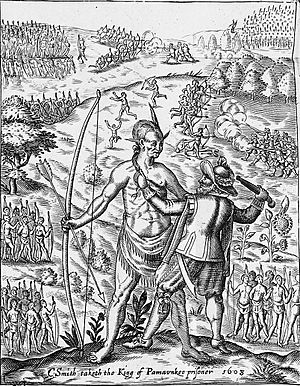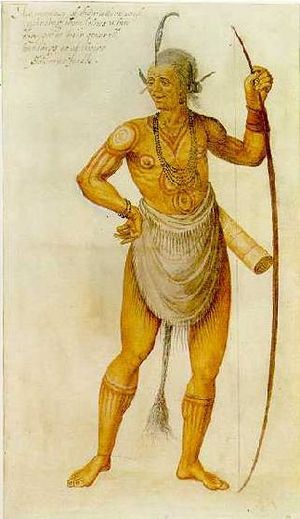Opechancanough facts for kids
Quick facts for kids
Opechancanough
|
|
|---|---|

'John Smith taking the King of Pamunkey prisoner', a fanciful image of Opechancanough from Smith's General History of Virginia (1624). The image of Opechancanough is based on a 1585 painting of another native warrior by John White (see below)
|
|
| Paramount chief of the Powhatan Confederacy | |
| Preceded by | Opitchipam |
| Succeeded by | Necotowance |
| Personal details | |
| Born | 1554 |
| Died | 1646 (aged 92) Jamestown, Colony of Virginia, British America |
| Cause of death | Shot in the back while a prisoner |
| Resting place | Pamunkey Reservation, King William, Virginia, U.S. |
| Relatives | Chief Powhatan (brother) Pocahontas (niece) John Rolfe (nephew-in-law) |
| Military service | |
| Allegiance | Powhatan Confederacy |
| Battles/wars | Anglo-Powhatan Wars |

Opechancanough (born 1554, died 1646) was a powerful leader of the Powhatan Confederacy. This was a group of Native American tribes in what is now Virginia. He became their main chief in 1618 and led them until he died.
Opechancanough was the younger brother of Chief Powhatan, who first brought these tribes together. Opechancanough took over as chief after Powhatan. He led his people in major conflicts against the English settlers, known as the Anglo-Powhatan Wars.
In 1646, when he was very old, Opechancanough was captured by the English. He was taken to Jamestown and later killed by a guard.
Contents
Who Was Opechancanough?
The name Opechancanough meant "He whose Soul is White" in the Powhatan language. This language was part of the Algonquian family.
The Powhatan Confederacy was formed in the late 1500s and early 1600s. It was led by Chief Wahunsonacock, also known as Chief Powhatan. He united more than 30 Native American tribes in the Tidewater region of Virginia. This area is the southeastern part of the modern state.
When the English built their settlement at Jamestown in May 1607, Opechancanough was a respected warrior and a strong leader among the Powhatans. He was Chief Powhatan's younger brother. His own tribe lived along the Pamunkey River.
Opechancanough was known for being against the European settlers. He once captured Captain John Smith near the Chickahominy River. Smith was then brought before Chief Powhatan at Werowocomoco. This was one of the Powhatan capital villages. It was here that Pocahontas, Powhatan's daughter, is said to have helped Smith.
Other settlers wrote that Pocahontas often helped keep peace between the Native Americans and the colonists. She also brought important food to the colonists during the winter of 1607–08. This was after a fire at their fort in Jamestown.
Leading the Powhatan People
The marriage of Pocahontas to English colonist John Rolfe in April 1614 brought a time of peace. However, this peace ended after Pocahontas died during a trip to England. Her father, Chief Wahunsonacock, also died in 1618.
After a short time, Opechancanough's older brother, Opitchapam, became chief. During this time, Opechancanough was the war chief. Soon after, Opechancanough became the main chief of the Powhatan Confederacy.
Conflicts between the Native Americans and the colonists grew worse. The English colonists wanted more land to grow tobacco, which was a very profitable crop. As more Europeans arrived, they built more settlements along the rivers.
Opechancanough decided to stop trying to make peace with the English. He wanted to force them to leave the region completely. On March 22, 1622, his forces launched a series of attacks. They killed many settlers along the James River. About one-third of the colonists in Virginia died.
However, the colony recovered. In return, the English killed many Native Americans. Some warriors were even poisoned by Dr. John Potts at Jamestown.
Final Efforts and Death
Chief Opechancanough made one last major effort to drive out the colonists on April 18, 1644. This was during the third Anglo-Powhatan War.
In 1646, forces led by Governor William Berkeley captured Opechancanough. At this time, he was thought to be between 90 and 100 years old. He was paraded as a prisoner through Jamestown. A settler who was guarding him later shot him in the back, killing him.
Before he died, Opechancanough reportedly said that if he had captured Governor Berkeley, he would not have shown him off to his people in such a way.
After Opechancanough's death, Necotowance became the next chief. Later chiefs included Totopotomoi and his wife, Cockacoeske. Cockacoeske is believed to be Opechancanough's daughter or granddaughter.
Representations in Media
Opechancanough has been shown in several films and TV shows:
- He was played by Stuart Randall in the 1953 film Captain John Smith and Pocahontas.
- He appeared in the 1994 episode "Pocahontas" from Animated Hero Classics.
- He was portrayed by Wes Studi in the 2005 film The New World.
- He appears in the Sky TV show Jamestown, played by Raoul Max Trujillo.

